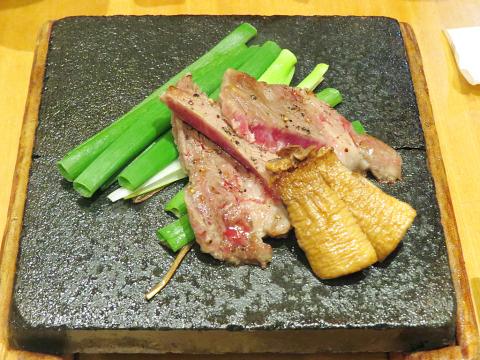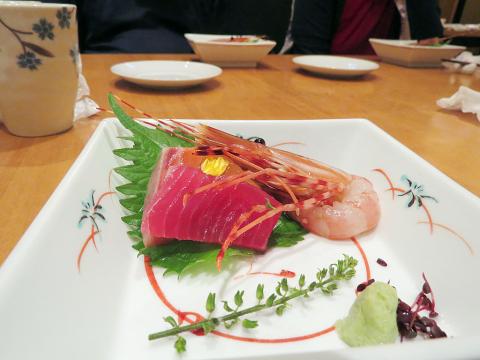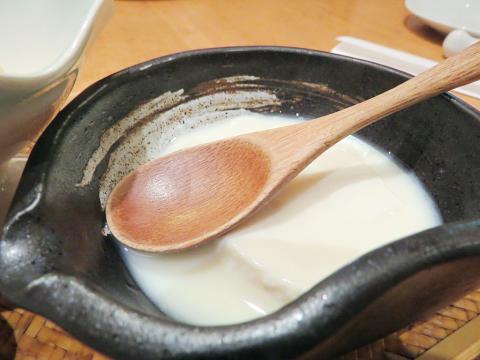EN Japanese Cuisine (EN日本料理) specializes in Japanese haute cuisine, notably the chef-recommended kaiseki (懷石), a traditional multi-course dinner consisting of small and precisely composed dishes.
At the top floor of Sogo’s Fuxing (復興) branch, the restaurant stands out with an understated entrance that is partially curtained and flanked by opaque glass. Patrons make their way past an open kitchen and some spare wooden tables, booths and box seats for privacy at the back of the restaurant.
On the dinner menu, there are hot pots (featuring four stocks made from scratch), as well as some eight-course kaisekis priced at NT$580 and up. Most individual dishes can also be ordered a la carte and assembled into a meal at less cost and time.

Photo: Enru Lin, Taipei Times
EN also offers nine-to-10 course kaisekis served all day — there’s the NT$1,000 and the NT$1,500, which uses the day’s most prized ingredients. For vegetarians, meat dishes can be swapped out, and upon request the raw fish can be steamed or fried into tempura.
On my visit, the NT$1,000 kaiseki starts with a wooden tray carrying two seasonal vegetables and a little leaf-shaped pot of tofu. It’s an instantly pleasing arrangement, featuring a dark bowl and pale ingredient on one side to balance another pale bowl and a dark ingredient on the other side. The tofu, a house specialty, is even nicer. Served without seasoning or sauce, it has a silky, slightly milky taste and feels as rich as a steamed egg custard.
Next there is sashimi: tuna, salmon and a large botan shrimp with a ruby-red head, garnished with a flower. This is top quality fish. Each glistening piece has an ocean scent and is just chilled enough so that the texture is soft yet springy.

Photo: Enru Lin, Taipei Times
Then there is barley-fed pork sprinkled with rock salt, followed by a salad in which the main attraction is a two-tiered dressing of tofu cream and a citrusy vinaigrette sauce. These are largely unmanipulated flavors, skillfully orchestrated, fresh and bright. The grilled beef with mushrooms and spring onion comes medium-rare on a hot black stone. It can be eaten as a steak after arrival, when the meat is intense and butter-tender, or after about three minutes on the stone when it comes together as a stir-fry.
EN is famed for its mochiri tofu, delivered in a frosted glass ensconced in an elegant bowl of ice chips. This concoction, which the waiter said is made in-house, is an improbable chewy tofu with a sweet and delicate aftertaste, just like a dessert.
The courses come and go, moving to more familiar staples like stewed fish and miso and rice, concluding with the diner’s choice of dessert. (The signature item is ice cream and one scoop of a sesame mousse which is slightly earthy and not too sweet.) From start to finish, this parade of tiny, dignified dishes takes about one hour, and at the end you leave feeling cheerier, older and wiser, though you might need to eat again in two hours.

Photo: Enru Lin, Taipei Times
EN Japanese Cuisine said yesterday that it uses cooking oil from Da Chan (大成集團). As of press time, no edible oil products from Da Chan have been subject to recall.

Photo: Enru Lin, Taipei Times

Photo: Enru Lin, Taipei Times

June 23 to June 29 After capturing the walled city of Hsinchu on June 22, 1895, the Japanese hoped to quickly push south and seize control of Taiwan’s entire west coast — but their advance was stalled for more than a month. Not only did local Hakka fighters continue to cause them headaches, resistance forces even attempted to retake the city three times. “We had planned to occupy Anping (Tainan) and Takao (Kaohsiung) as soon as possible, but ever since we took Hsinchu, nearby bandits proclaiming to be ‘righteous people’ (義民) have been destroying train tracks and electrical cables, and gathering in villages

Dr. Y. Tony Yang, Associate Dean of Health Policy and Population Science at George Washington University, argued last week in a piece for the Taipei Times about former president Ma Ying-jeou (馬英九) leading a student delegation to the People’s Republic of China (PRC) that, “The real question is not whether Ma’s visit helps or hurts Taiwan — it is why Taiwan lacks a sophisticated, multi-track approach to one of the most complex geopolitical relationships in the world” (“Ma’s Visit, DPP’s Blind Spot,” June 18, page 8). Yang contends that the Democratic Progressive Party (DPP) has a blind spot: “By treating any

Swooping low over the banks of a Nile River tributary, an aid flight run by retired American military officers released a stream of food-stuffed sacks over a town emptied by fighting in South Sudan, a country wracked by conflict. Last week’s air drop was the latest in a controversial development — private contracting firms led by former US intelligence officers and military veterans delivering aid to some of the world’s deadliest conflict zones, in operations organized with governments that are combatants in the conflicts. The moves are roiling the global aid community, which warns of a more militarized, politicized and profit-seeking trend

This year will go down in the history books. Taiwan faces enormous turmoil and uncertainty in the coming months. Which political parties are in a good position to handle big changes? All of the main parties are beset with challenges. Taking stock, this column examined the Taiwan People’s Party (TPP) (“Huang Kuo-chang’s choking the life out of the TPP,” May 28, page 12), the Democratic Progressive Party (DPP) (“Challenges amid choppy waters for the DPP,” June 14, page 12) and the Chinese Nationalist Party (KMT) (“KMT struggles to seize opportunities as ‘interesting times’ loom,” June 20, page 11). Times like these can